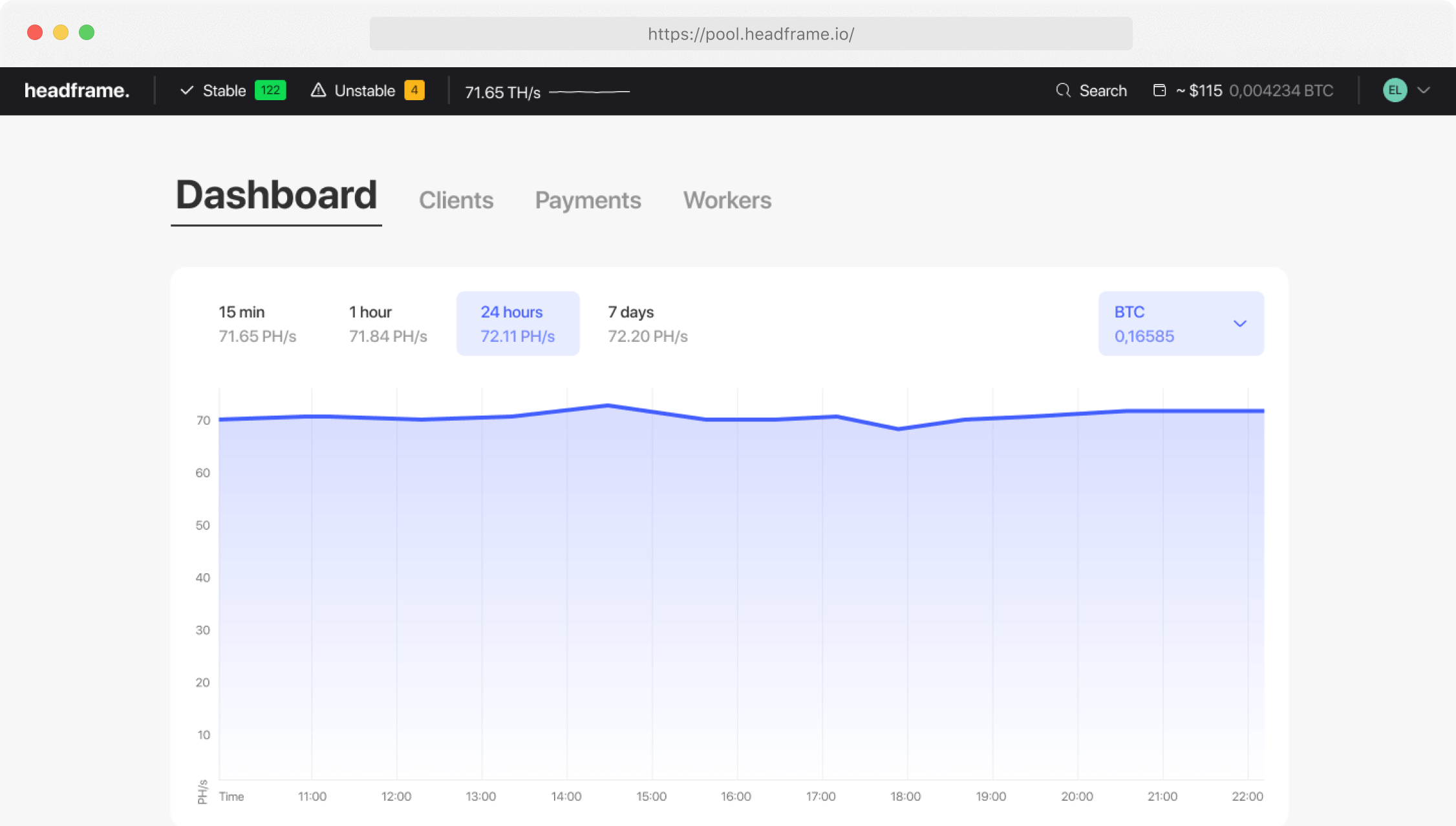Analysis of Mining Pool Resilience to Cryptocurrency Volatility
Mining pools play a vital role in the cryptocurrency ecosystem by uniting miners’ efforts for efficient digital asset extraction. However, fluctuations in cryptocurrency markets can significantly impact their operation and profitability. Analyzing the resilience of mining pools to these fluctuations helps understand how they adapt to changing conditions and maintain stability. Let’s explore the strategies and mechanisms mining pools use to sustain stability amid cryptocurrency market volatility.
Earn more money with Headframe
Join a mining pool and get the best profitability in mining. Already more than 10,000 miners trust Headframe.
Cryptocurrency markets are known for their high volatility, characterized by significant and often unpredictable price swings of digital assets. These fluctuations can be driven by various factors, including regulatory changes, market sentiment, technological innovations, and macroeconomic events. In such a volatile environment, mining pools must develop strategies to minimize risks and ensure stable income for their participants.
Diversification
One of the key strategies for maintaining the resilience of mining pools is diversification. Diversification can involve spreading computational power across different cryptocurrencies and mining algorithms. This helps reduce dependence on price fluctuations of a single cryptocurrency and mitigates risks associated with potential technological changes or regulatory measures. Diversification also allows mining pools to better adapt to changes in mining difficulty and maintain stable incomes for their participants.
Financial Management
Effective financial management is crucial for the resilience of mining pools. Efficiently managing income and expenses helps mining pools maintain financial stability and preparedness for unforeseen market changes. Developing and adhering to budgets, monitoring income and expenses, and creating reserve funds help mining pools navigate periods of low profitability and sustain growth. Financial management also includes analyzing market trends and forecasting future changes, enabling mining pools to develop strategic plans and adapt to new conditions.
Technological Innovations
Technological innovations are another essential aspect of mining pool resilience. Using advanced technologies and equipment helps improve performance and reduce mining costs. This includes implementing energy-efficient miners, optimizing mining algorithms, and using renewable energy sources. Technological innovations allow mining pools to remain competitive and attractive to participants, contributing to their long-term resilience.
Regulatory Compliance
Regulatory changes can significantly impact the operation of mining pools, so compliance with legislation and interaction with regulators is vital. Mining pools must monitor regulatory changes and adapt to new requirements to avoid legal issues and ensure the legitimacy of their operations. Transparency and adherence to regulatory requirements strengthen the trust of participants and investors, contributing to stability and income growth.
Participant Engagement
Interaction with pool participants and supporting their engagement is also crucial for the resilience of mining pools. Maintaining an active dialogue with participants, providing quality technical support, and educating them on new methods and technologies help improve interaction and satisfaction. Educational initiatives and training sessions help participants better understand and utilize modern technologies, leading to more efficient work and increased income. Active engagement with participants helps mining pools quickly address emerging issues and adapt to changes.
Artificial Intelligence and Machine Learning
The use of artificial intelligence (AI) and machine learning (ML) for data analysis and forecasting also contributes to the resilience of mining pools. These technologies enable mining pools to analyze large volumes of data in real-time, identify trends and patterns, and develop future forecasts. This helps mining pools make informed decisions and quickly adapt to market changes. AI and ML can also optimize mining processes and improve resource management.
Partnerships and Collaboration
Partnerships and collaboration with other mining pools and companies also play an essential role in resilience. Combining efforts and sharing knowledge and resources help mining pools develop and implement new technologies, improve infrastructure, and enhance operational efficiency. Partnership relationships foster the creation of a global ecosystem where innovations can quickly spread and adapt to various conditions, contributing to the overall resilience and competitiveness of mining pools.
Environmental Sustainability
Environmental sustainability is becoming increasingly important for mining pools. The high energy consumption of cryptocurrency mining significantly impacts the environment, and using renewable energy sources helps reduce the carbon footprint. Investments in energy-efficient technologies and optimizing energy consumption help reduce costs and improve the environmental sustainability of mining operations. Supporting environmental initiatives and participating in projects to restore and protect natural resources help improve the environmental situation in the region.
Social Responsibility
Social responsibility and interaction with local communities also play a vital role in mining pool resilience. Supporting social projects, participating in educational programs, and supporting local economies help strengthen ties between mining pools and communities. This contributes to creating a more sustainable and inclusive cryptocurrency ecosystem and improves the reputation of mining pools.
In conclusion, the resilience of mining pools to cryptocurrency fluctuations depends on various factors. Diversification, financial management, technological innovations, regulatory compliance, participant engagement, the use of artificial intelligence and machine learning, partnerships, environmental sustainability, and social responsibility all play critical roles in maintaining the stability and efficiency of mining pools. Understanding and implementing these strategies help mining pools effectively navigate challenges and seize opportunities to achieve long-term success in the cryptocurrency industry.


